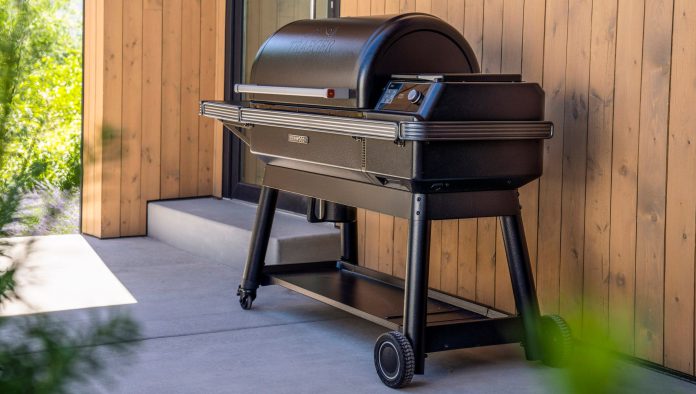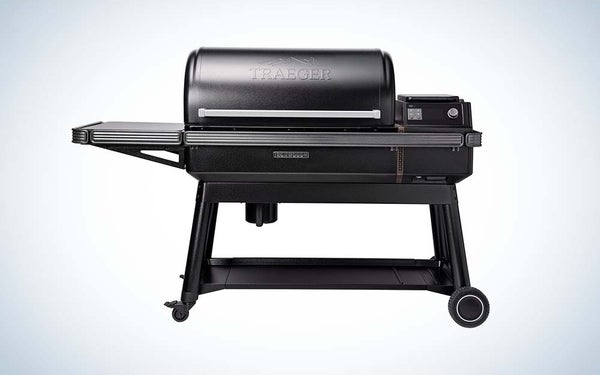We may earn revenue from the products available on this page and participate in affiliate programs. Learn more ›
Traeger’s recently improved Ironwood and Ironwood XL hit the sweet spot of price and performance, taking many features and tech from Traeger’s high-end grills and putting them into the more affordable but uncompromising smoker. We got our hands on the reimagined Ironwood XL and had the chance to put it through its paces.
The new Ironwood draws on the technology and design of Traeger’s Timerbline models but comes in at nearly half the price, making high-end performance more attainable to the rest of us. At $1,799 for the standard and $1,999 for the XL Model, the Ironwood is by no means cheap, but you get what you pay for with a Traeger—and then some. It allows you to grill, smoke, bake, roast, braise, and barbecue all with one appliance. And Traeger’s simple interface makes the whole process as easy as using a home oven. Here’s a more in-depth look at our test of the Ironwood
Traeger Ironwood Specs and Features
Ironwood
- Main Cooking surface: 396 Sq. Inches
- Upper rack: 220 Sq. Inches
- Total Cooking Area: 616 Sq. Inches
- Hopper Capacity: 22 Pounds
- Temperature Range: 165-500 F
- Length (with side shelf): 59″
- Width: 25″
- Height: 48″
- Weight: 199 lbs
Ironwood XL
- Main cooking surface: 594 Sq. Inches
- Upper rack: 330 Sq. Inches
- Total Cooking Area: 924 Sq. Inches
- Hopper Capacity: 22 Pounds
- Temperature Range: 165-500 F
- Length (with side shelf): 70″
- Width: 25″
- Height: 48″
- Weight: 243 lbs
Traeger Ironwood Build Quality
The new and improved Ironwood comes in two sizes, a standard model with around 616 square inches of cooking area and the larger Ironwood XL with 924 square inches. Both models are only available in black and sport 22-pound pellet hoppers. For our test, we cooked on the Ironwood XL.
The grill’s body is made of heavy-gauge steel with a thick weather-sealed exterior paint job. The inside of the grill is treated with a smooth protective coating and is designed almost like a two-basin sink, with the firepot on one side and a grease and ash trap on the other. The drip tray funnels any liquid or grease from cooking into a removable aluminum lined keg on the bottom, while a small blower pushes spent ash from the firepot into the keg from the other side. This design keeps ash out of the food, makes clean up easy, and reduces the risk of flare-ups during cooking.

The chamber and hood of the Ironwood are dual-walled and heavily insulated to promote temperature consistency and retention. The Ironwood also has a gasket around the hood and cooking area that locks in smoke and heat when the lid is closed. Heavy-duty hinges support the hood, and it does not feel flimsy like many other pellet smokers I have used.
Instead of a chimney, the Ironwood uses a Downdraft exhaust on the back of the grill, which works in tandem with the Ironwood’s Tru Convection design and a system of fans to circulate heat and smoke for faster, more efficient cooking and a smokier flavor. This system also plays into the Super Smoke mode, which, when enabled, promotes higher smoke concentration and penetration into the food.
High-Tech Grilling
The Ironwood’s touch screen interface and navigation wheel make it as easy to use as a home oven. But what really sets the grill apart are the electronics Traeger installed in them. The updated Ironwood takes many features from the more expensive Traeger Timberline models, including the D2 controller.

The D2 controller is the brain of the system. It automatically adjusts things like the fan speed, auger speed, and other inputs to keep the temperature, smoke concentration, and everything else at the desired level while cooking. The controller powers systems that also help shorten startup time, and helps the grill return to the proper temperature more quickly after lifting the lid.
The upgraded D2 controller also includes a new diagnostic function for errors and hardware malfunctions, which can help you fix issues or replace parts if needed. And it allows you to connect the grill to Traeger’s smartphone app to monitor and control the grill from anywhere, plus gain access to over 1600 step-by-step recipes. You can even go hands-free with some select smart home systems like Amazon Alexa or Google Home if you’re into that kind of thing.
Other Exterior Features on the Traeger Ironwood
The Ironwood comes with a side-mounted shelf that can be used as a work surface and will eventually serve as a point to add modular burners and other add-ons, such as a pizza oven in the future. Around the outside of the grill, Traeger’s Pop and Lock rail system lets you mount accessories like a paper towel/butcher paper holder, tool holders, a spice/sauce rack, etc.
Underneath, the Ironwood has a hopper trapdoor for speedy pellet flavor changes or emptying the hopper for storage. Both Ironwood models come with a new sturdy bottom shelf, and there’s a groove to accept a pellet bin (sold separately, but should be included in my opinion). The grill sits on two “all-terrain” wheels on one side and two locking caster wheels on the other.
A few other small features include a built-in grill light that shines directly on the grill grates, meat probes, and side walls inside the grill to block the wind. The hopper also has a light so you can see what you’re doing in the dark and a sensor to warn you when you’re low on pellets. The grill grates and upper rack are coated with a porcelain non-stick surface that’s also rust-resistant and durable.

How We Tested the Traeger Ironwood XL
We put the Ironwood XL through its paces—testing most of, if not all, of the features and functions of the grill. We cooked several meals to test the full range of Ironwood’s capabilities and judged the grills on how they handled these three basic temperature ranges:
1) Low-Temperature Smoking
Most pellet smokers bottom out at 150-200 degrees Fahrenheit, which is important for smoking fish, jerky, cheese, etc. Here we looked at whether the smoker has a low-temperature setting and if the controller can maintain a relatively consistent low temperature throughout the cook without frequent or dramatic fluctuation. To test this, we low-smoked a salmon fillet.
2) Medium-to-High Temperature Smoking
The 200-400+ degree range is used for smoking and roasting loins, shoulders, chicken, brisket, etc. This temperature range is also used for cooking vegetables, baking casseroles, pastries and desserts, and more. To test this, we par-smoked a venison neck which we made into a tray of nachos which we also smoked. We also made brisket and a few racks of ribs.

3) High-Temperature Grilling and Roasting
The 400-500+ degrees range is used for grilling and roasting and when you want to sear meat. Here we looked for whether the grill has a high maximum temperature, how the drip tray/grease trap performed, the non-stick performance of the racks, and whether there was even temperature distribution. To test this, we grilled venison backstrap coated in a dry rub, some marinaded pork loins, and a pile of venison burgers. We cooked them individually and loaded the grill to max capacity to see how it handled a crowded cooking surface.
How the Traeger Ironwood Performed
What it did well
Of the pellet smokers I have owned and used, the Ironwood is hands down the best. Full stop. The grill arrives more-or-less built, and there’s minimal assembly needed other than installing the legs and bottom shelf. It took me about an hour to assemble, but I could have done it faster.
Once assembled, the burn-in and setup are extremely easy, and the grill basically holds your hand through the whole process. I had zero issues or any hiccups with feeding or ignition.
Once I started cooking, I noticed the Ironwood has phenomenal temperature consistency. Whether at the bottom or top of its temperature range, the grill stayed within 20 degrees of the set temperature at all times and usually within 5 degrees—which is really good.

Cosmo Genova
There was a bit more fluctuation with the Super Smoke Mode and at the higher temperatures for grilling, but that’s to be expected. The Ironwood’s Smart Combustion and Turbo Temp features do an excellent job of keeping the grill at the desired temperature and recovering from temperature drops when opening the lid.
The Ironwood can go down to 165 degrees Fahrenheit at its lowest and stay consistently at temp within a very small margin. It smoked the salmon fillet to perfection without temperature spikes and would be great for other low-temperature recipes like jerky.
The Ironwood also does an excellent job of imparting smoke into the food, even on short cooks, and it didn’t skip a beat for longer cooks that ran ten or more hours. Food had a noticeably better smoky quality than other pellet smokers I’ve used. I know this sounds like BS, but it’s absolutely true.
The Ironwood is laid out well and it handles grease and ash without an issue. It’s by far one of the cleanest burning smokers I’ve used, and it will undoubtedly last a lot longer because of it. Finicky, delicate parts like the ignition system and thermocouple are almost always the first things to go on pellet grills, but the design of the Ironwood ensures they stay clean and undamaged.
Due to the layout of my house and where I tested the grill, I couldn’t dive into the WiFIRE features and Traeger app as much as I would have liked. That said, it’s a very intuitive and user-friendly system that I’ve enjoyed using, and I’ve heard nothing but praise from Traeger owners.
What it could do better
There’s not much to complain about with the Ironwood unless you want to get nitpicky. For a pellet grill, the Ironwood does an excellent job searing and grilling. Truth be told, I’ve never enjoyed grilling on a pellet grill, and I don’t think they can compete with propane and charcoal. The strength of a Pellet grill is in barbecuing and smoking, not searing and grilling. It’s nice that they can do it, but it’s not the best tool for the job. To be fair, the Ironwood did a surprisingly good job, and I was impressed with how well the meat retained moisture.
I think the grill relies a little too much on the touchscreen for control. I would have liked to see the navigation wheel offer a bit more functionality for when you’ve got wet or dirty hands. Also, the drip tray will inevitably rust because of the material it’s made from. I would have liked to see commercial-grade stainless steel used instead of relying on aluminum foil or buying Traeger’s tray liners. However, I understand a heavy stainless drip tray might be cost-prohibitive.

The Bottom Line on the Traeger Ironwood
The Ironwood XL is built like a tank, easy to use, performs a variety of tasks exceptionally well, and offers all the high-tech and connectivity features of much more expensive grills. While so many companies withhold features and bake planned obsolescence into their products, it’s nice to see Traeger bringing legitimate innovations and design improvements to their grills.
Read Next: The Best Camping Grills of 2023
The fact that Traeger offers so many premium features and build quality in the comparably affordable Ironwood is a win for everyone. And while shelling out almost $2,000 for a smoker is still a significant investment, the Ironwood is worth the money.
Traeger products just work, and while you might save a few bucks on a cheaper pellet grill from a lesser-known company, the Ironwood will save you a lot of headaches in the long run.









